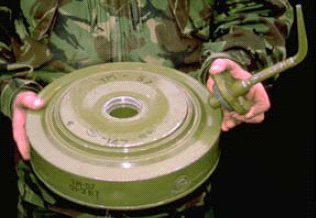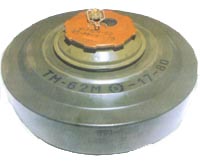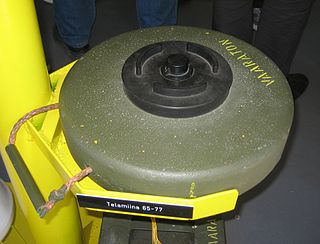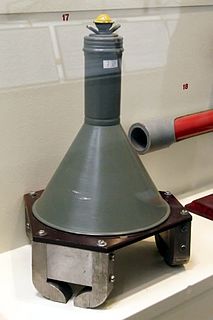
A land mine is an explosive device concealed under or on the ground and designed to destroy or disable enemy targets, ranging from combatants to vehicles and tanks, as they pass over or near it. Such a device is typically detonated automatically by way of pressure when a target steps on it or drives over it, although other detonation mechanisms are also sometimes used. A land mine may cause damage by direct blast effect, by fragments that are thrown by the blast, or by both.

The MT-LB is a Soviet multi-purpose fully amphibious auxiliary armored tracked vehicle, which was first introduced in the 1950s. It is also produced in Poland, where its YaMZ engine replaced by Polish one.

The TM-57 mine is a large, circular Soviet metal-cased blast anti-tank mine. It can either be triggered by a pressure or a tilt-rod fuze. A development of the TM-46 mine, it is found in Africa, the Middle East, and South East Asia.
The PT Mi-K is a Czechoslovakian metal-cased anti-tank blast landmine. The mine uses a metal grid instead a pressure plate, this gives it resistance to overpressure. The mine is no longer produced, but is found in Afghanistan, Cambodia, Eritrea, Namibia, Nicaragua and the Western Sahara.
The M7 is a small, metal-cased United States anti-tank blast mine that was used during the Second World War. It was based on the British Hawkins grenade. Approximately 2.5 million were produced before production ceased, and although it has long since been withdrawn from U.S. service, it can be found in Angola, Burma, Cambodia, Chad, Eritrea, Ethiopia, Korea, Lebanon, Myanmar, Somalia, Thailand, and Zambia.

TM-62 is the designation for a series of Soviet anti-tank blast mines. The mines have a central fuze and typically have a 7.5 kg explosive charge, however they vary greatly in detail. The mines can be laid manually or automatically from a mine laying machine including the PMR-1, PMR-2 wheeled towed mine layers, the GMZ tracked mine laying vehicle and the VMR-2 helicopter mine laying system.
The M/71 is a large Egyptian metal-cased anti-tank blast mine based on the Russian TM-46 landmine. It is found in Egypt and Somalia. The mine is normally painted sand colored. The fuse is susceptible to overpressure and the mine is easily detectable.
The MAT-76 is a large circular Romanian minimum metal anti-tank blast mine. It is similar to the MAT-62B mine, sharing a fuze. The mine is actually a cast block of TNT with a thin coating of fibreglass. The mine has a central fuze well that normally uses a P-62 pressure fuze, although it can be used with any of the fuzes designed for the Russian TM-62 and TM-72 series of mines. The bakelite plastic used in the fuze of a MAT-76 may become brittle in desert conditions, which can reduce the activation pressure. This may make the mine unstable i.e. can detonate simply by handling it. The mine is found in Angola, Iraq, Kuwait, Liberia, Mozambique, and Zambia.
The P2 Mk2 and P3 Mk2 are Pakistani plastic cased minimum metal anti-tank blast mines. The P2 Mk2 has a square case with a central circular ribbed pressure plate, the P3 is circular with a central circular pressure plate. Both mines use anti-personnel mines as the fuse, typically the either the P4 Mk1 or P2 Mk2 anti-personnel mines. The anti-personnel mine sits in a cavity below the pressure plate, when enough pressure is place on the pressure plate of the mine, it collapses onto the anti-personnel mine triggering it and the main charge which sits below it. A yellow canvas carrying strap is normally fitted to the side of the mine. The mines have a secondary fuse well on the bottom which can be used with anti-handling devices. A GLM-2 electronic booby trap can be fitted to the cavity under the pressure plate. The mine is supplied with a steel disc which makes the mine more easily detectable, although this is seldom used. Since 1997 only a detectable version of the mine has been produced, and to comply with the Convention on Conventional Weapons amended protocol II, Pakistani stocks of the mine are being retrofitted with steel detection discs. The mines are found in Afghanistan, Angola, Eritrea, Ethiopia, Pakistan, Somalia, and Tajikistan.

The TMA-4 is a circular plastic cased Yugoslavian minimum metal anti-tank blast mine. It is a modernized version of the TMA-3. The mine is basically a cast block of TNT with three fuze wells cut into it, encased in plastic. Three black plastic UTMA-4 fuzes are installed into the top surface of the mine. A thin rope carry handle is also provided. The small pressure plate area of the fuzes make the mine resistant to overpressure from explosive demining techniques. Additionally the low metal content of the mine make it very difficult to detect. Although no secondary fuze well is provided, it is possible that the mine could be fitted with improvised anti-handling devices.

The TM 65 is a circular Finnish minimum metal anti-tank blast mine. It is broadly based on the Russian TM-62 mine. The mines body is made from a thin shell of fibreglass over a cast block of explosive, with a central fuze well that holds the pressure fuze. The original TM 65 used a US-65 fuze as used in the SM-65 anti-personnel mine, the later TM 65 77 uses a pressure fuze similar to the Russian MV-5 fuze called Painesytytin 77.
The MATS/2 is a scatterable Italian circular, plastic-cased minimum metal blast resistant anti-tank blast mine. It uses a pneumatic fuse which is resistant to shock and blast similar to the fuse fitted to the TS-50. The mine's plastic case is waterproof, and the mine can be scattered from a helicopter traveling at up to 200 km/h using the Tecnovar DAT dispensing system. A secondary fuse well is provided in the base for the fitting of anti-handling devices.
The AUPS is a circular Italian bakelite cased minimum metal anti-personnel blast mine. The mine can be adapted with a steel fragmentation jacket and stake into a fragmentation stake mine. The mine is constructed in two halves, with the upper half containing the pressure fuse mechanism, the lower half contains the main charge and the detonator. The mine case is normally unpainted bakelite brown.
The PPMP-2 is a Yugoslavian anti-personnel stake mine. The mine was not mass-produced, but was built in large quantities at a number of different locations.

The Hafthohlladung, also known as the "Panzerknacker" was a magnetically-adhered, shaped charge anti-tank grenade used by German forces in World War II, sometimes described as a mine.
NATO AEP-55 STANAG 4569 is a NATO Standardization Agreement covering the standards for the "Protection Levels for Occupants of Logistic and Light Armored Vehicles".

The SPG Kalina is a heavy, multi-purpose armoured personnel carrier designed at the OBRUM and is produced by the Bumar Łabędy company - part of Polish military consortium - Bumar Group. SPG is a development of the joint Poland, Soviet Union and East Germany transporter called MT-S, developed in the late 1980s.

The Mahindra Mine Protected Vehicle-I (MPV-I), is an Indian MRAP-type armored personnel carrier manufactured by Defense Land Systems, a joint-venture of Mahindra & Mahindra Limited and BAE Systems, the first vehicle made under the venture. It is an improved Casspir variant built under licence.










